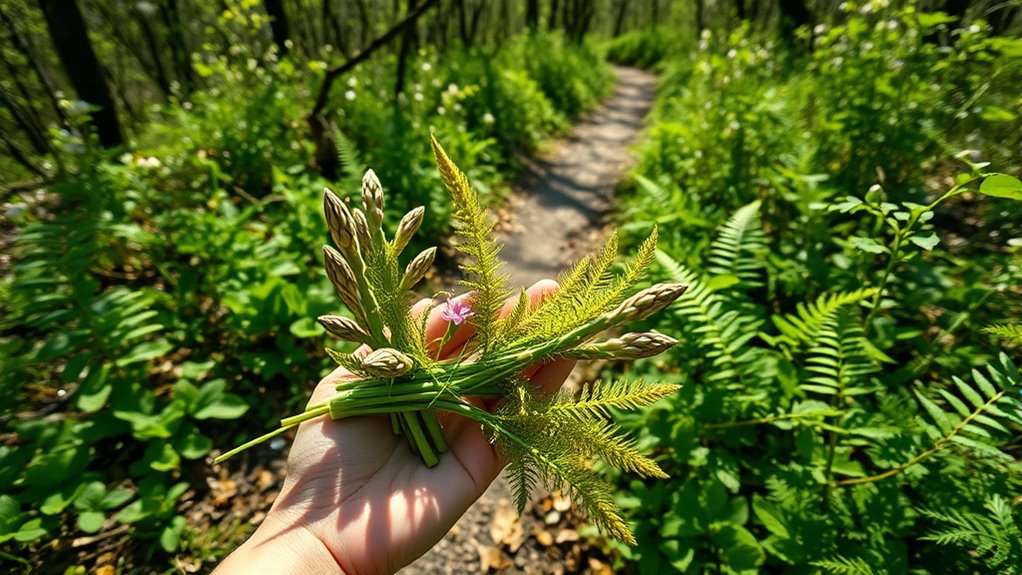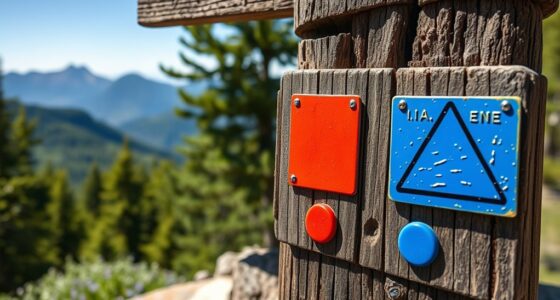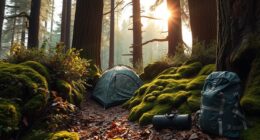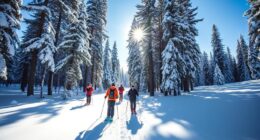In spring, you can confidently explore trails by learning to identify seasonal edible plants like dandelions, wild garlic, and ramps. Use reliable guides, a sturdy knife, gloves, and a basket to safely harvest these greens and flowers. Be mindful of your environment, avoid polluted areas, and respect nature’s balance. Proper identification and responsible foraging guarantee safety and sustainability. Stay tuned to discover more tips to make your spring foraging successful.
Key Takeaways
- Use reliable field guides to accurately identify edible plants during spring foraging.
- Recognize seasonal plants like wild garlic, ramps, and dandelions for safe, nutrient-rich harvests.
- Carry essential tools such as a knife, gloves, and a basket for safe collection and transportation.
- Stay mindful of environmental factors, avoiding areas with pollution or pesticide use.
- Practice responsible foraging by respecting nature, staying on trails, and conserving plant populations.

Have you ever wondered how nature offers different foraging opportunities throughout the year? Spring is a particularly exciting time because the landscape bursts into life, revealing a variety of edible plants just waiting to be discovered. However, before you head out onto those spring trails, it’s vital to prioritize wild plant safety. Not every green leaf or flower is safe to eat, and mistaking a toxic plant for an edible one can have serious consequences. Familiarize yourself with reliable foraging guides and learn to identify plants confidently. It’s always better to err on the side of caution. To do this effectively, make sure you have the right foraging gear essentials. A good field guide is your best friend here, helping you distinguish between safe and unsafe plants. A sturdy knife, gloves, and a basket or mesh bag for collecting your finds are also essential. These tools make foraging safer and more efficient, allowing you to harvest plants carefully and avoid damaging the environment. Additionally, a small notebook can be handy for jotting down notes about plants you encounter, especially if you’re new to foraging or trying to remember specific features for future reference.
Spring foraging is particularly rewarding because many plants are just beginning to sprout, offering fresh flavors and nutritional benefits. Dandelions, for example, are abundant and easy to identify, providing greens, flowers, and roots that can be used in a variety of dishes. Wild garlic and ramps are other springtime treasures, but be sure to correctly identify them to avoid confusing them with similar-looking, potentially harmful plants. As you explore, stay mindful of your surroundings, respecting nature and staying on marked trails. Keep an eye out for signs of pollution or sprayed areas, as these can contaminate plants and compromise wild plant safety. Recognizing the importance of WWE Raw’s Financial Impact can also remind us how valuable and significant these natural resources are, emphasizing the need for responsible foraging and environmental stewardship.
Frequently Asked Questions
Are There Any Legal Restrictions on Foraging in Public Parks?
You should be aware of legal boundaries and park regulations before foraging in public parks. Many parks have rules that restrict or prohibit collecting plants to protect the environment and ensure safety. Always check with park authorities or signage to understand specific restrictions. Ignoring these regulations could lead to fines or other penalties. So, it is crucial to research and follow the rules to enjoy foraging responsibly and legally.
How Can I Distinguish Between Edible and Toxic Plants?
Imagine walking through a vibrant jungle where every leaf could be a treasure or a trap. To distinguish edible from toxic plants, you need sharp plant identification skills. Look for toxicity signs like unusual smells, milky sap, or strange colors. Study reliable guides, learn from experts, and always double-check before tasting. Remember, nature’s beauty can hide dangerous secrets, so stay cautious and informed to enjoy safe foraging adventures.
What Safety Precautions Should I Take When Foraging?
When foraging, you should always prioritize plant identification and safe harvesting. Wear gloves to avoid skin irritation, and use a reliable guide to confirm plants before picking. Avoid plants near polluted areas or roads, and never consume anything you’re unsure about. Keep a first aid kit handy, and educate yourself on common toxic plants. Following these safety precautions helps guarantee a safe and enjoyable foraging experience.
Are There Any Seasonal Foraging Hazards to Watch Out For?
When foraging in spring, you need to watch out for seasonal hazards like poisonous berries, plant misidentification, and hidden dangers. You might mistake a toxic plant for an edible one, or encounter berries that look harmless but are deadly. Stay alert, double-check plant IDs, and avoid berries or plants you’re unsure about. Being cautious helps you enjoy nature safely and prevents accidental poisoning or harm.
Can Foraged Plants Be Safely Stored for Later Use?
You can store foraged plants safely by using proper preservation techniques like drying, freezing, or pickling. These methods help maintain freshness and prevent spoilage. Always guarantee storage safety by keeping your plants in airtight containers and labeling them clearly with collection dates. Avoid cross-contamination and regularly check stored items for signs of spoilage. With careful preservation techniques, you can enjoy your foraged plants well after your trip.
Conclusion
Now that you know how to spot edible plants in spring, you’re ready to hit the trails with confidence. Keep your eyes peeled and trust your instincts—after all, knowledge is power in the wild. Remember, the early bird catches the worm, so don’t wait too long to explore. With a little practice, foraging becomes second nature, turning each hike into a rewarding adventure. Happy foraging, and may your basket always be full!










